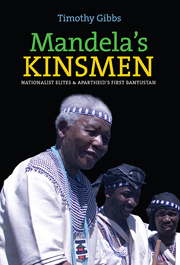Book contents
- Frontmatter
- Contents
- List of Maps and Figures
- Acknowledgements
- List of Abbreviations
- Introduction: Mandela' Kinsmen
- 1 Education, Monarchy & Nationalism
- 2 The First Bantustan, 1954–1963
- 3 The Second Peasants' Revolt, Mpondoland 1960–1980
- 4 The Old Mission Schools, 1963–1980
- 5 The Comrade-King, Bantustan Politics 1964–1980
- 6 Chris Hani's Guerrillas, 1974–1987
- 7 The Apartheid Endgame, 1987–1996
- 8 The New South Africa & Transkei's Collapse, 1990 onwards
- Conclusion: African Nationalism & its Fragments
- Bibliography
- Index
Conclusion: African Nationalism & its Fragments
Published online by Cambridge University Press: 05 April 2014
- Frontmatter
- Contents
- List of Maps and Figures
- Acknowledgements
- List of Abbreviations
- Introduction: Mandela' Kinsmen
- 1 Education, Monarchy & Nationalism
- 2 The First Bantustan, 1954–1963
- 3 The Second Peasants' Revolt, Mpondoland 1960–1980
- 4 The Old Mission Schools, 1963–1980
- 5 The Comrade-King, Bantustan Politics 1964–1980
- 6 Chris Hani's Guerrillas, 1974–1987
- 7 The Apartheid Endgame, 1987–1996
- 8 The New South Africa & Transkei's Collapse, 1990 onwards
- Conclusion: African Nationalism & its Fragments
- Bibliography
- Index
Summary
Commemorating Mandela's kinsmen
On 1 October 2008, South Africa's new National Heritage Council laid on a feast at Bumbane to commemorate the memory of Sabata Dalindyebo, a close relative of Nelson Mandela, whose story has threaded through the pages of this book. National politicians and well connected chiefs flew in from Cape Town and Johannesburg; the cow to be slaughtered was apparently trucked across the Transkei, having been donated by the Zulu king. The social landscape of Transkei has changed hugely since Sabata Dalindyebo and Nelson Mandela grew up in rural Thembuland in the first decades of the 20th century. A dignitary driving from Umtata Airport to Bumbane in 2008 might have passed through Umtata's town centre, congested with businessmen buying groceries and bottled beer to transport out to the rural locations, where they would be sold on in smaller spaza shops and drinking shebeens. (This vibrant consumer market almost entirely depends on pensions and welfare grants that play a vital role in the Bantustans, where jobs are scarce.) The route then leaves Umtata and passes a dozen small settlements strung along the roadside, where smart brick houses with satellite TV stand next to small zinc shacks; some with electricity, piped water and government-issued pit latrines, others without. Even Qunu – so evocatively described in Nelson Mandela's autobiography – has become one of these ribbon settlements, favoured because it lies close to a busy, national road. Finally, the route cuts off onto a gravel road leading to Bumbane.
- Type
- Chapter
- Information
- Mandela's KinsmenNationalist Elites and Apartheid's First Bantustan, pp. 176 - 184Publisher: Boydell & BrewerPrint publication year: 2014



